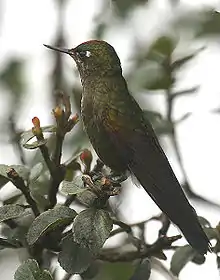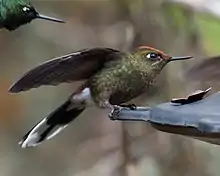Rainbow-bearded thornbill
The rainbow-bearded thornbill (Chalcostigma herrani) is a species of hummingbird in the family Trochilidae. It is found in Colombia, Ecuador, and Peru. Its natural habitat is subtropical or tropical high-altitude grassland.
| Rainbow-bearded thornbill | |
|---|---|
.jpg.webp) | |
| Male in Yanacocha Reserve, Ecuador | |
 | |
| Female in northwest Ecuador | |
| Scientific classification | |
| Kingdom: | Animalia |
| Phylum: | Chordata |
| Class: | Aves |
| Order: | Apodiformes |
| Family: | Trochilidae |
| Genus: | Chalcostigma |
| Species: | C. herrani |
| Binomial name | |
| Chalcostigma herrani | |
Taxonomy
The rainbow-bearded thornbill was formally described in 1846 by the French ornithologists Adolphe Delattre and Jules Bourcier from specimens collected near the town of Pasto in southwest Colombia. They coined the binomial name Trochilus herrani.[2] This bird is now one of five species placed in the genus Chalcostigma that was introduced in 1854 by the German naturalist Ludwig Reichenbach.[3][4] The genus name derives from the Greek khalkos ″bronze″ and stigma ″mark″. The specific epithet heranni was chosen to honour the Colombian general and statesman Pedro Alcántara Herrán.[5]
Two subspecies are recognised:[4]
- C. h. tolimae Kleinschmidt, O, 1927 – west-central Colombia
- C. h. herrani (Delattre & Bourcier, 1846) – south Colombia across Ecuador to north Peru
Description
A medium-sized hummingbird, about 10.8-10.9cm in length, with a short, needle-like bill. The bird is mostly dark green with a white dot behind the eye, black primaries and white undertail coverts. The head has a long, rufous crest. The gorget ("beard"), more prominent in the male bird, is a rainbow of colours from celadon-green through turquoise to yellow and red at the lower end. The large tail is dark purple with prominent white tips at the corners. These white tips are most easily seen from below. The feet are black. Female birds are pale yellowish-ochre from lower the belly to the undertail coverts.[6] Juvenile birds have white speckles on the throat and no beard.[7]
Distribution and habitat
A hummingbird of high altitudes, it is typically found from 2800 to 4100m in Colombia and 2800-3700m in Ecuador.[8][7] Its primary habitat is elfin forest, open country with bushy patches and small woodlands, and gulleys with thickets of ferns and bromeliads.[6]
Behaviour and ecology
This species typically forages alone. It is very territorial. It will chase off competitors for food sources, even if they are considerably larger (e.g. flowerpiercers) and will not tolerate other hummingbirds even on large fruiting trees.[6][7]
References
- BirdLife International (2012). "Chalcostigma herrani". IUCN Red List of Threatened Species. 2012. Retrieved 26 November 2013.
- Delattre, Adolphe; Bourcier, Jules (1846). "Description de quinze espèces nouvelles de Trochilidées, faisant partie des collections rapportées par M. Ad. De Lattre, dont les précédentes excursions ont déjà enrichi plusieurs branches de l'histoire naturelle, et provenant de l'intérieur du Pérou , des républiques de l'Équateur, de la Nouvelle-Grenade et l'isthme de Panama". Revue Zoologique (in French). 9: 305–312 [309].
- Reichenbach, Ludwig (1854). "Aufzählung der Colibris Oder Trochilideen in ihrer wahren natürlichen Verwandtschaft, nebst Schlüssel ihrer Synonymik". Journal für Ornithologie (Supplement) (in German). 1: 1-24 [12].
- Gill, Frank; Donsker, David; Rasmussen, Pamela, eds. (July 2020). "Hummingbirds". IOC World Bird List Version 10.2. International Ornithologists' Union. Retrieved 2 January 2020.
- Jobling, James A. (2010). Helm Dictionary of Scientific Bird Names. London: Christopher Helm. pp. 98, 190. ISBN 978-1-4081-2501-4.
- Restall, Robin; Rodner, Clemencia; Lentino, Miguel (2006). Birds of Northern South America: an Identification Guide. New Haven: Yale University Press. pp. Vol 1 pp270-271. ISBN 978-0-300-10862-0.
- Freile, Juan F.; Restall, Robin (2018). Birds of Ecuador. London: Helm. p. 244. ISBN 978-1-4081-0533-7.
- Ayerbe Quiñones, Fernando (2018). Guía ilustrada de la Avifauna colombiana. Bogotá: Punto aparte. pp. Pl 29. ISBN 978-958-5461-03-1.
- McMullan, Miles (2018). Field guide to the birds of Colombia. [Bogotá, Colombia]: Rey Naranjo Editores. p. 57. ISBN 978-958-8969-77-0.

